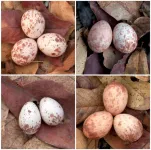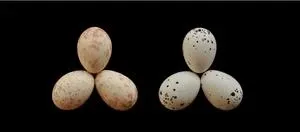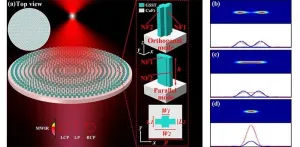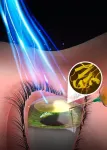(Press-News.org) Images and paper available at: https://drive.google.com/drive/folders/1mPYnFKIEArlXUAaFk5H7YTepezntqerj?usp=sharing
African cuckoos may have met their match with the fork-tailed drongo, which scientists predict can detect and reject cuckoo eggs from their nest on almost every occasion, despite them on average looking almost identical to drongo eggs.
Fork-tailed drongos, belligerent birds from sub-Saharan Africa, lay eggs with a staggering diversity of colours and patterns. All these colours and patterns are forged by the African cuckoo.
African cuckoos lay their eggs in drongos’ nests to avoid rearing their chick themselves (an example of so-called brood parasitism). By forging drongo egg colours and patterns, cuckoos trick drongos into thinking the cuckoo egg is one of their own.
But drongos use knowledge of their own personal egg ‘signatures’ – their eggs’ colour and pattern –to identify cuckoo egg ‘forgeries’ and reject them from their nests, say scientists. These ‘signatures’ are like the signatures we use in our daily lives: unique to each individual and highly repeatable by the same individual.
Through natural selection, the African cuckoo’s eggs have evolved to look almost-identical to drongo eggs – a rare example of high-fidelity mimicry in nature.
A team led by researchers at the University of Cambridge and the University of Cape Town, working in collaboration with a community in Zambia, set out to explore the effectiveness of ‘signatures’ as a defence against highly accurate mimicry.
They found that despite near-perfect mimicry of fork-tailed drongo eggs, African cuckoo eggs still have a high probability of being rejected.
The findings are published today in the journal, Proceedings of the Royal Society B.
Researchers carried out field work in the Choma district of Zambia during September to November across four years. The first step was to measure the differences in colour and pattern of the fork-tailed drongo eggs and cuckoo eggs. The team found that the colour and pattern of cuckoo eggs was, on average, almost identical to that of drongo eggs, and that all the broad types of drongo egg ‘signatures’ were forged by the cuckoos.
“It is incredible how perfect the mimicry is. We have occasionally missed cuckoo eggs in the field because they looked exactly like the drongo clutch that they were found in,” said lead researcher and Zoology PhD student Jess Lund.
The second step involved ‘egg rejection’ experiments in which the researchers simulated cuckoo visits by ‘parasitising’ drongo nests with foreign eggs from other drongo nests (as a proxy for African cuckoo eggs). They then checked the nest daily to see whether the drongo parents accepted the foreign egg as one of their own, or realised it was an imposter and rejected it by removing it from their nest. The team could then test what differences in colour and pattern between the foreign egg and the drongo’s own eggs best predicted whether or not the drongo parents were tricked.
By combining results from both steps of the study, the researchers were able to create a model that predicted how often, on average, an African cuckoo would have its eggs rejected by a fork-tailed drongo host. They found the predicted rate of rejection to be 93.7%.
“We were surprised to see that so many of the cuckoo eggs were predicted to be rejected”, said Lund “Our additional simulations show this is likely due to drongos having evolved ‘signatures’ on their eggs. Even though cuckoos have evolved excellent ‘forgeries’, individual cuckoos don’t target individual drongo nests that match their own eggs. This means that for each cuckoo egg laid, the likelihood that it will be a good enough match to that drongo’s ‘signature’ is very low.”
Fork-tailed drongos have likely honed these ‘signatures’ and detection abilities through natural selection, explains Lund. “It’s very costly for drongo parents if they don’t have these skills. If they can’t tell a ‘forgery’ from their ‘signature’ their own chicks will be killed by the cuckoo when it hatches, and they will be stuck raising a ravenous cuckoo for a whole breeding season.”
The results of the study suggest that a female cuckoo may only fledge two chicks in her lifetime – only just replacing herself and her mate. Researchers say that this would not amount to a sustainable population, which presents a puzzle because African cuckoos remain a common bird in many parts of Africa.
The researchers think that the fork-tailed drongos where the research took place could be particularly good at spotting ‘forgeries’. “Perhaps this part of Zambia is a hotspot for parasitism, where drongos have particularly fine-tuned defences, and against which cuckoos stand little chance,” said Lund.
The research was supported by the DST-NRF Centre of Excellence at the FitzPatrick Institute at the University of Cape Town, the BBSRC, the Royal Society, and the Department of Zoology at the University of Cambridge, and carried out with the crucial support of a community in Zambia who find and access drongo nests.
ENDS.
Reference:
Lund et al. When perfection isn’t enough: host egg signatures are an effective defence against high-fidelity African cuckoo mimicry, Proceedings of the Royal Society B, DOI: 10.1098/rspb.2023.1125
Contact details:
Charis Goodyear, University of Cambridge researchcommunications@admin.cam.ac.uk
Jess Lund, University of Cambridge jl2171@cam.ac.uk
About the University of Cambridge
The University of Cambridge is one of the world’s leading universities, with a rich history of radical thinking dating back to 1209. Its mission is to contribute to society through the pursuit of education, learning and research at the highest international levels of excellence.
Cambridge was second in the influential 2023 QS World University Rankings, the highest rated institution in the UK.
The University comprises 31 autonomous Colleges and over 100 departments, faculties and institutions. Its 20,000 students include around 9,000 international students from 147 countries. In 2022, 72.5% of its new undergraduate students were from state schools and more than 25% from economically disadvantaged backgrounds.
Cambridge research spans almost every discipline, from science, technology, engineering and medicine through to the arts, humanities and social sciences, with multi-disciplinary teams working to address major global challenges. In the Times Higher Education’s rankings based on the UK Research Excellence Framework, the University was rated as the highest scoring institution covering all the major disciplines.
The University sits at the heart of the ‘Cambridge cluster’, in which more than 5,200 knowledge-intensive firms employ more than 71,000 people and generate £19 billion in turnover. Cambridge has the highest number of patent applications per 100,000 residents in the UK.
www.cam.ac.uk
END
Egg ‘signatures’ will allow drongos to identify cuckoo ‘forgeries’ almost every time, study finds
African cuckoos may have met their match with the fork-tailed drongo, which scientists predict can detect and reject cuckoo eggs from their nest on almost every occasion, despite them on average looking almost identical to drongo eggs.
2023-07-26
ELSE PRESS RELEASES FROM THIS DATE:
A novel approach for balancing properties in composite materials
2023-07-26
Dr. Amir Asadi, an assistant professor in the Department of Engineering Technology and Industrial Distribution at Texas A&M University, is making groundbreaking strides in the field of composite materials. His research explores embedding patterned nanostructures composed of multiple materials into high-performance composites to achieve the desired multifunctionality without sacrificing any other properties. This could lead to advancements in various fields, including electronics, energy storage, transportation and consumer products.
Asadi's work has significant implications, as it addresses the challenge of simultaneously enhancing two properties — multifunctionality ...
One simple brain hack might boost learning and improve mental health
2023-07-25
DURHAM, N.C. – Shifting from a high-pressure mindset to a curious one improves people’s memory.
New research from Duke found that people who imagined being a thief scouting a virtual art museum in preparation for a heist were better at remembering the paintings they saw, compared to people who played the same computer game while imagining that they were executing the heist in-the-moment.
These subtle differences in motivation — urgent, immediate goal-seeking versus curious exploration for a future goal — have big potential for framing real-world challenges such as encouraging people ...
$13.7 million NIAID grant will fund novel study on multidrug resistant organisms
2023-07-25
The National Institute of Allergy and Infectious Diseases (NIAID) has awarded a $13.7 million, five-year grant to a team of researchers to investigate multidrug resistant organisms (MDROs) in nursing homes throughout the United States.
The multidisciplinary research team includes CUNY Graduate School of Public Health (CUNY SPH) Professor Bruce Y. Lee and is led by University of California, Irvine (UCI) School of Medicine infectious diseases expert Dr. Susan Huang.
Using one of the world’s largest compilations of specimens from healthcare facilities, the team will study six antibiotic-resistant organisms deemed as serious and urgent ...
Protein found to protect females against obesity
2023-07-25
RIVERSIDE, Calif. -- Associated with poorer mental health outcomes and reduced quality of life, obesity is on the rise in the United States. Currently, more than 30% of American adults are classified as obese. A risk factor for several diseases, including diabetes, cardiovascular disease, and COVID-19, obesity is an important and growing public health concern.
Using a mouse model of high fat diet-induced obesity, a team of scientists at the University of California, Riverside, has found that, compared to males, female mice are protected against obesity and inflammation because they secrete more of an immune protein called RELMalpha.
“Our ...
Enhancing image quality with broadband achromatic and polarization-insensitive metalenses
2023-07-25
Precise control of light is a crucial requirement in optical imaging, sensing, and communication. Traditional lenses employed for the purpose have limitations, necessitating more precise and compact solutions. To address this need, researchers have developed metalenses, ultrathin lenses constructed from nanomaterials that are smaller in size than the wavelength of light. These sub-wavelength elements provide the means to manipulate light waves with exceptional precision, facilitating a precise control of the amplitude, phase, polarization, and direction of light waves.
Moreover, compared to bulky lenses, metalenses are ...
Study links alcohol-associated liver disease to abnormal cutting and rejoining of molecules
2023-07-25
SAN ANTONIO (July 25, 2023) — Alcohol consumption is a major cause of chronic liver disease. The disease, which has devastating consequences, progresses through stages of hepatitis (inflammation), fibrosis (scarring) and cirrhosis (severe scarring). Advanced disease increases the risk of developing liver cancer, and some individuals may require a liver transplant to live.
Despite a tremendous need for new treatments, the specific biological factors that determine when and how rapidly liver cells deteriorate remain largely unknown.
In a study published May 3 in the journal Hepatology, a research team at The University of Texas Health Science Center at San Antonio (UT Health San ...
Menstrual cups can help prevent infection, improve vaginal health
2023-07-25
Many girls in low- and middle-income countries struggle to buy products to manage their periods, which can cause them to skip school. So, ensuring they have access to menstrual products is critical.
A new Kenya-based study from University of Illinois Chicago researchers shows that the benefits of one kind of menstrual product — a menstrual cup — extend well beyond educational access. Teenage girls who were given menstrual cups were less likely to acquire certain kinds of vaginal infections and were more likely to have a healthy vaginal microbiome, the study found. The findings are published ...
Healing power of light: University of Ottawa team advances clear vision for eye repair
2023-07-25
An injectable biomaterial activated by pulses of low-energy blue light has tremendous potential for on-the-spot repair to the domed outer layer of the eye, a team of University of Ottawa researchers and their collaborators have revealed.
Guided by biomimetic design—innovation inspired by nature—the multidisciplinary researchers’ compelling results show that a novel light-activated material can be used to effectively reshape and thicken damaged corneal tissue, promoting healing and recovery.
This technology is a potential game-changer in corneal repair; tens of millions of people ...
Study offers objective insights to near-miss collisions between drones, airplanes
2023-07-25
Researchers have developed a new way to accurately count and objectively analyze close encounters between drones and airplanes — without depending solely on pilot sightings.
In a peer-reviewed study published by the Society of Automotive Engineers in the “SAE International Journal of Aerospace,” researchers looked at more than 1.8 million piloted aircraft operations and nearly 460,000 flights by small-uncrewed aerial systems (sUAS) around Dallas-Fort Worth Airport, a major hub.
Between August 2018 and July 2021, researchers with Embry-Riddle Aeronautical University and Unmanned Robotic Systems Analysis (URSA) identified 24 near-midair collisions (NMACs) in which ...
Department of Energy announces $4.6 million for research on public-private partnership awards to advance fusion energy
2023-07-25
WASHINGTON, D.C. - Today, the U.S. Department of Energy (DOE) announced $4.6 million in funding for 18 projects at national laboratories and U.S. universities. The awards are provided through the Innovation Network for Fusion Energy, or INFUSE, program, which was established in 2019. The program is sponsored by the Fusion Energy Sciences (FES) program office within DOE’s Office of Science and is focused on accelerating fusion energy development through public-private research partnerships.
“The latest round of INFUSE selections demonstrates the growing interest from private industry in partnering with national laboratories and U.S. universities,” said Jean ...
LAST 30 PRESS RELEASES:
Rare image of Tatooine-like planet is closest to its twin stars yet
Music: Popular song lyrics have become more negative since 1973
Marine ecology: Killer whales tail dolphins to hunt salmon
ADHD prescriptions on the rise, study finds
How to build a genome
Sharp rise in ADHD stimulant prescriptions in Ontario, research finds
Trends and prevalence of the metabolic syndrome among US adults
Population-level trends in ADHD medication prescribing
Missing piece of myelin disturbs the brain’s rhythm
Insilico Medicine and Taigen achieves license agreement to develop and commercialize AI-driven PHD inhibitor for anemia of Chronic Kidney Disease (CKD)
Exploring dominant endophytic Pleosporales in grasses: New taxonomic insights in the suborder Massarineae
Comparative transcriptomic analysis of human maxillary and mandibular tooth germs reveals discrepancies in gene expression patterns
Scientists detect atmosphere on molten rocky exoplanet - study
Chip-scale magnetometer uses light for high-precision magnetic sensing
Illinois Tech biomedical engineering professor Philip R. Troyk elected as Fellow of the National Academy of Inventors
The National Academy of Inventors welcomes 2025 Class of Fellows
Multi-scale modelling framework predicts mechanical responses of Fe–Cr–Al alloys across composition and processing conditions
Preoperative radiation may improve antitumor immune response in most common form of breast cancer
Breast MRI may be safely omitted from diagnostic workup in certain patients with early-stage, HR-negative breast cancer
Sentinel lymph node biopsy may be safely omitted in some patients with early-stage breast cancer
Rats may seek cannabis to cope with stress
New FAU research strengthens evidence linking alcohol use to cancer
Gut health à la CAR T
Dr. Pengfei Liu receives 2026 O'Donnell Award in Medicine for pioneering advances in genetic diagnostics and rare disease treatment
Dr. Yunsun Nam receives 2026 O'Donnell Award in Biological Sciences for pioneering RNA research transforming gene regulation and cancer therapy
Dr. Bilal Akin wins 2026 O'Donnell Award in Engineering for transformative work in EV energy systems and industrial automation
Dr. Fan Zhang receives 2026 O'Donnell Award in Physical Sciences for groundbreaking discoveries in quantum matter and topological physics
Dr. Yue Hu receives 2026 O'Donnell Award for revolutionizing energy operations with real-time AI and reinforcement learning
Greater risk that the political right falls for conspiracy theories
JMC Publication: Insilico’s AI platforms enable discovery of potent, selective, oral DGKα inhibitor to overcome checkpoint resistance
[Press-News.org] Egg ‘signatures’ will allow drongos to identify cuckoo ‘forgeries’ almost every time, study findsAfrican cuckoos may have met their match with the fork-tailed drongo, which scientists predict can detect and reject cuckoo eggs from their nest on almost every occasion, despite them on average looking almost identical to drongo eggs.






